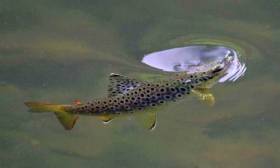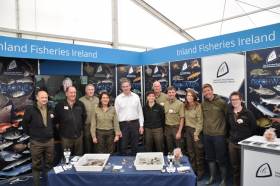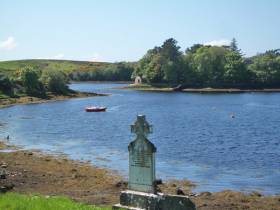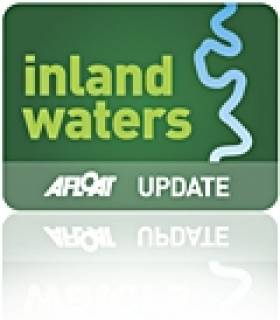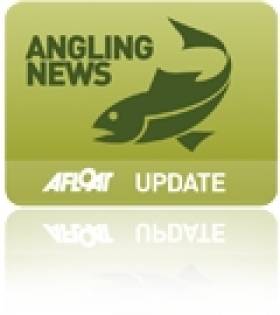Displaying items by tag: Byelaws
New Protections For Wild Brown Trout As Designated Salmonid Waters Bye-law Comes Into Operation
#Angling - The Designated Salmonid Waters Bye-law was yesterday (Thursday 25 October) signed by the Minister for Communications, Climate Action and Environment, Richard Bruton.
The overall intention behind the bye-law is to afford additional protection to wild brown trout in seven distinctive State–owned waters where established stock control measures are already in place as a matter of existing policy.
The seven waters are Lough Sheelin in the Limerick Fishery District; Loughs Conn and Cullin the Ballina Fishery District; Loughs Corrib, Mask and Carra in the Galway Fishery District; and Lough Arrow in the Sligo Fishery District.
Sean Canney, who is succeeding Sean Kyne as Minister of State with responsibility for the inland fisheries sector, welcomed the bye-law as an important initiative for brown trout fisheries particularly in the West of Ireland.
“My predecessor Seán Kyne gave notice of his proposals to make the bye-law and also instigated a public consultation during which observations and views expressed across the full range of stakeholders,” said Minister Canney.
“I am happy as incoming minister to support Minister Kyne’s long-standing initiative and his hard work over all of 2018 in bringing the bye-law to fruition.”
Minister Kyne said: “As minister with responsibility for inland fisheries, I had carefully considered the submissions made in the public consultation.
“The bye-law relates to seven limestone lakes which are quite unique in terms of topography and trout habitat and have long been managed as wild brown trout fisheries via established stock management programmes. From that perspective, I considered that these waters are especially important.
“The bye-law was just about complete when I was taking on my new role and I am grateful for the support of Ministers Bruton and Canney for bringing it over the line,” he added.
The bye-law gives statutory status to the policy designation of this small number of distinctive waters and means that the waters concerned will continue to be managed primarily as brown trout waters.
Minister Kyne had indicated his view that the importance of these waters should be reflected by way of statutory designation and commenced that process in the department.
The bye-law also includes the prohibition on the introduction of fish to the designated waters which is consistent with the overall policy thrust of Inland Fisheries Ireland to manage these waters primarily as brown trout waters.
The advantages of this measure include addressing biosecurity and genetic concerns, control and management of the potential transfer of pathogens, and safeguarding against the introduction of alien invasive fish species.
The announcement came as Bord Iascaigh Mhara is hosting a two-day conference on the scientific developments within the salmon farming industry in Galway’s Maldron Hotel on 25-26 of October.
Outlining the purpose of the event, BIM’s Geoffrey Robinson said: “With increasing global demand for fish, aquaculture is now the fastest-growing animal food production sector in the world. Consequently, fish farming operations are rapidly evolving with new technologies and equipment constantly being developed.
“Part of BIM’s work is to help fish farmers to keep their operations at the cutting edge of technology and an event like this allows us to showcase the latest innovations to Irish operators. There will be a number of interesting developments discussed not least the growing use of cleaner fish and desalination systems.”
Twenty-five separate presentations from national and international experts will cover the latest research and technological developments within the sector on issues such as fish health and welfare, structural and service equipment as well as organic certification.
“While production volumes in Ireland are small by international standards, we have a reputation for excellence in organic salmon production and it is important that our operations maintain this high standard. Incorporating leading edge technologies can improve our production efficiencies and strengthen our sustainable practices,” Mr Robinson added.
In 2017 Irish salmon production increased 15.6% to 19,305 tonnes, with a value of €141.2 million. The industry employs 210 people, primarily in production sites along the west coast of Ireland. Irish salmon is exported to diverse markets across the EU, North America and the Near and Far East.
New Angling Bye-Laws For Corrib Catchment In Galway & Mayo
#Angling - Seán Kyne, Minister of State with responsibility for the inland fisheries sector, has signed off three new angling bye-laws which affect the Corrib catchment in Galway and Mayo.
The bye-laws, which have been requested by local angling clubs, concern the Abbert and Grange Rivers, the Clare River and the Cong River and Canal, and reflect the support of the clubs for the conservation imperative and the sustainable management of the local fisheries resource.
The Abbert and Grange Rivers (Annual Close Season) Bye-Law extends the closed season for all angling on the Abbert and Grange Rivers by two months to cover the period from the 1st of September until the 31st of March annually.
This bye-law is being introduced at the request of the angling clubs on the Clare system and will act as a vital conservation measure.
Both rivers make a significant contribution to wild brown trout stocks in the Clare River system and Lough Corrib. The new bye-law will afford greater protection to spawning salmonids in these two very important tributaries of the Clare River.
The Western Fisheries Region River Clare (Revocation) Bye-Law permits all legal angling methods on the Clare River from Daly’s Bridge in the townland of Corrandrum to a point 300 metres upstream of the footbridge at Anbally in the townlands of Anbally and Turloughmartin, Co Galway.
This section of river was previously restricted to fly fishing only. However, this new bye-law will bring this short section of the river into line with the rest of the Clare River. This bye-law was introduced at the request of the local angling club.
The Upper and Lower Limits of Cong River and Cong Canal Bye-Law clearly defines the upstream boundary between Lough Mask and the Cong Canal and the downstream boundary between the Cong River and Lough Corrib.
The purpose of the bye-law is to enable the effective enforcement of legislation governing the open angling seasons for trout and salmon on the Cong Canal/River as these differ from the open seasons for these species on Loughs Corrib and Mask.
This bye-law will also remove any difficulty in identifying the correct angling season at the extremities of the Cong River/Canal and will afford greater protection to highly prized ferox trout which are known to spawn in the Cong River/Canal.
“We welcome the introduction of these bye-laws in Galway and Mayo which will help us to enforce relevant legislation and enhance the resource in the long term,” said Inland Fisheries Ireland chief executive Dr Ciaran Byrne.
“The introductions of these bye-laws follow public consultations whereby stakeholders were invited to input their views and insights into the proposed new regulations. Inland Fisheries Ireland’s fisheries officers will now protect these rivers in line with the new laws in place.”
Anglers are requested to familiarise themselves with the details of the new bye-laws, which can be found on the website of the Department of Communications, Climate Action & Environment.
#InlandWaters - The new Heritage Bill passed by the Dáil last week will not mandate inland waterways officers to present copies of relevant bye-laws to canal users, where in print or electronically.
Galway West TD Éamon Ó Cuív’s proposed amendment to the text was shot down as “unnecessary” by Heritage Minister Josepha Madigan in the debate stage.
“Other enforcement agencies and bodies, such as conservation rangers, gardaí and inland fisheries officers, operate in the same way,” she said. “It is good practice for users of the waterways to become familiar with the legislation governing the waterways and the marine notices in place. It would confuse the role of the authorised officer.”
The minister clarified that access to relevant bye-laws governing the use of inland waterways “is not an issue”.
“They will be available on devices, such as smartphones or tablets. I cannot accept a situation, however, where temporary unavailability, such as a dropped phone or a gap in internet signal, results in the authorised officer being unable to carry out his or her functions,” Minister Madigan said.
New Angling Bye-Laws For Lough Muckno, Lough Lene & River Vartry
#Angling - Three new angling bye-laws have been introduced in the Eastern River Basin District by Minister of State with responsibility for Inland Fisheries, Sean Kyne.
Conservation of Coarse Fish and Pike Dundalk District (Lough Muckno) Bye-law No 950, 2017 has been introduced for Lough Muckno, near Castleblaney in Co Monaghan.
This bye-law provides for catch and release for all coarse fish and pike on the lough. Anglers must use keep nets to hold any coarse fish or pike and all fish are to be subsequently released.
The regulations apply to Lough Muckno including Gas Lake and the waters up to Derrygreevy Bridge, the tributary up to Frankfort Bridge, County Water up to Wallace’s Bridge and the Clarebane River up to Clarebane Bridge.
On Lough Lene in Collinstown, Co Westmeath, the Annual Close Season Bye-law No 322, 2017 now applies.
This new bye-law has extended the open season such that anglers fishing for brown trout or rainbow trout can now fish from 1 March until 12 October.
On the River Vartry in Co Wicklow, the River Vartry System (Conservation Bag Limit) Bye-law No 952, 2017 has been introduced.
An angler is now permitted to take one sea trout (40cm or less) per day from the river during the open season, which runs from 1 March to 30 September. The River Vartry is closed for fishing for salmon and sea trout over 40cm.
All three bye-laws came into effect on 1 October 2017.
Inland Fisheries Ireland’s Dublin director Brian Beckett said: “These new bye-laws are designed to protect and conserve a range of fish species while supporting important angling amenity activities within the Eastern River Basin District.
“These fish populations are valuable from a number of perspectives including biological diversity and angling amenity and Inland Fisheries Ireland hope that these measures serve to reinforce the importance of protecting and conserving all our fisheries in the future.”
#Angling - An angling bye-law focusing on salmon and sea trout has come into effect for Burrishoole, Co Mayo.
Sean Kyne, Minister of State with responsibility for Inland Fisheries, introduced the Conservation of Salmon and Sea Trout Shramore (Burrishoole)(Catch and Release) Bye Law No 951 into operation on Tuesday 13 June.
The new bye-law provides for catch and release angling for salmon and sea trout over 40cm in length in the Shramore (Burrishoole) system, and applies to Lough Furnace and the Seven Arch Bridge on the L5435 (old Newport Road).
Operative from Wednesday 14 June till Saturday 30 September, the bye-law and provides for the use of single barbless hooks while prohibiting the use of worms as bait in angling for salmon and sea trout.
‘Catch and release’ angling refers to the method of carefully handling any fish caught and immediately returning the fish alive to the water. This form of angling has a significant positive impact on the survival rate of released fish.
In addition, salmon and sea trout caught by fly fishing using single barbless hooks have a greater chance of survival than fish caught on barbed hooks. Barbless hooks do less damage, are easier to remove and reduce handling time which can be an important factor influencing survival.
Salmon and sea trout are some of Ireland’s main wild fish species attracting domestic and overseas anglers alike. Angling contributes €836 million to the Irish economy annually and supports upwards of 11,000 jobs which are often in rural communities.
Dr Ciaran Byrne, chief executive of Inland Fisheries Ireland, said: “Our salmon and sea trout stocks are extremely valuable. These new measures at Shramore, Burrishoole, will allow us to introduce a number of important methods which will help us protect these populations into the future.”
Anglers are requested to familiarise themselves the details of the new bye-law, available as a PDF to read or download HERE.
Angling Bye-Law For Trout Conservation In Shannon Basin
#Angling - A new bye-law to help conserve brown trout has been introduced in for the Shannon River Basin District.
Seén Kyne, Minister of State with responsibility for Inland Fisheries, introduced the Conservation of Trout (No.8 or Limerick District) Bye-Law no.949 of 2017 into operation on Wednesday (14 June).
The new bye-law outlines a number of regulations around trout angling in the area.
It provides for an annual closed fishing season in certain waters, a daily bag limit of brown trout, a minimum size of trout to be taken in the specified waters and maximum number of rods to be used at any one time.
The waters included are the River Shannon, Lough Sheelin, Lough Derravaragh, Lough Owel, Lough Ennell, Lough Ree and Lough Derg, which are all located in the Limerick District.
Brown trout is one of Ireland’s indigenous fish species and is highly regarded by most domestic and tourist anglers alike, making it one of Ireland’s most valuable angling species.
Due to Ireland’s temperate climate and the shallow productive nature of its lakes, Ireland is the only country in Western Europe where lakes can support large trout stocks, which provides unique angling opportunities for fly fishermen.
Research commissioned by Inland Fisheries Ireland (IFI) indicates that expenditure by brown trout anglers contributes in the region of €148 million to the Irish economy annually.
Amanda Mooney, director of the Shannon River Basin District for IFI, said: “Trout is a valuable angling species which needs to be managed in a conservation focused manner. The new measures will help improve brown trout stocks and ensure they continue to provide quality angling for local and tourist anglers alike into the future.”
Anglers are requested to familiarise themselves with the details of the new bye-law, which will be made available on the IFI website.
#Angling - Inland Fisheries Ireland (IFI) is seeking submissions from interested parties in relation to proposals to introduce two bye-laws on the Clare River system, and a bye-law defining the upstream and downstream boundaries of the Cong Canal/River – both in the Western River Basin District.
The proposals currently under consideration for the Clare River sysrem are to request the minister to introduce two bye-laws as follows:
- Revoke bye-law 841 of 2008 to permit all legal angling methods on the Clare River from Daly’s Bridge in the townland of Corrandrum to a point 300m upstream of the footbridge at Anbally in the townlands of Anbally and Turloughmartin, Co Galway. This section of river is currently fly-only and the proposed bye-law will bring it into line with the rest of the Clare River.
- Extend the closed season for all angling on the Abbert and Grange Rivers by two months to cover the period 1 September to 31 March annually. This bye-law is being proposed as a conservation measure having regard to the very significant contribution of both of these rivers to wild brown trout stocks in the Clare River system and Lough Corrib.
Meanwhile, the proposal under consideration for the Cong Canal/River is to request a bye-law that would clearly define the upstream boundary between Lough Mask and the Cong Canal and the downstream boundary between the Cong River and Lough Corrib.
The purpose of the proposed bye-law is to enable the effective enforcement of legislation governing the open angling seasons for trout and salmon on the Cong Canal/River as these differ from the open seasons for these species on Loughs Corrib and Mask.
If considered necessary, IFI may decide to arrange a public consultation meeting on any or all of the proposed bye-laws. All submissions must be received in writing and will be published on the IFI website.
Submissions should be marked 'Public consultation- Clare River system' or 'Public consultation - Cong Canal/River' respectively, and be submitted by email to [email protected] or by post to:
The Director,
Inland Fisheries Ireland,
Teac Breac,
Earl’s Island,
Galway
The public consultation period will run for four weeks and the closing date for receipt of submissions is 5pm on Thursday 11 August 2016.
#Angling - Inland Fisheries Ireland (IFI) is seeking submissions from interested parties in respect of a number of proposed Bye-laws pertaining to the Eastern and Neagh Bann International River Basin Districts.
IFI intends requesting the minister to introduce these Bye-laws with a view to enabling improved management of these waters in a sustainable manner.
The key Bye-laws to be introduced and the areas being considered for review are as follows:
- To set the annual close season for angling for all trout species for Lough Lene, Co. Westmeath to the period 13 October to the last day of February inclusive.
- To introduce a bag limit of one sea trout under 40cm (the River Vartry is a closed fishery under the Salmon and Sea trout Angling Regulations, 2016) per day during the angling season on the River Vartry from the date of the signing of these regulations to the 31 December 2018.
- To prohibit the killing of any coarse fish or pike from the waters of Lough Muckno, Co Monaghan from the date of the signing of these regulations to the 31 December 2018.
IFI may, as part of the process, arrange a public consultation meeting if deemed necessary, but all submissions must be received in writing and will be published on the Inland Fisheries Ireland website at www.fisheriesireland.ie.
All submissions received by IFI will be published on its website. In addition, IFI is subject to the provisions of the Freedom of Information Act 1997 and therefore has to consider any request made to it under that Act. If you consider that any part of your submission would be subject to any of the statutory exclusions under that Act please so indicate in your submission, specifying under which exemption you believe the content should be excluded.
Submissions should be clearly marked ‘ERBD Byelaw Consultation’ and sent by email to [email protected] or by post to:
The Director,
Inland Fisheries Ireland Dublin,
3044 Lake Drive,
Citywest,
Dublin 24
The closing date for receipt of submissions is 5pm on 13 June 2016.
'Ongoing Liaison' Over Canal Bye-Law Proposals
#InlandWaters - Discussions between the Department of Heritage and Waterways Ireland over new draft bye-laws for Ireland's canals are "ongoing", according to Minister Heather Humphreys.
The minister was responding to a Dáil question on Thursday (30 April) from Kildare North TD Bernard Durkin on what moves have been made on the controversial bye-law changes suggested in last summer's report by Waterways Ireland.
"I am aware that concerns have been raised regarding certain aspects of the proposed bye-laws," she wrote, while reiterating her previous statement of 10 February last that the main stakeholders, as well as current permit holders on the three waterways – the Royal and Grand Canals and the Barrow Navigation – were invited to submit their views.
Though the minister did not address specific concerns such as those raised by the Inland Waterways Association of Ireland (IWAI) – which produced a long list of criticisms – she repeated the position that there is "ongoing liaison" between Waterways Ireland and her department, and that any final draft of bye-laws would be referred to her to decide upon.
She added that it is her "intention to afford interested deputies and senators an opportunity to discuss the proposals" before such a decision is made.
#Angling - Inland Fisheries Ireland (IFI) is seeking submissions from interested parties to update and amend existing Trout Bye-laws currently in operation in the Shannon River Basin District.
It is noted that the existing bye-laws in the Shannon catchment are for certain angling waters ambiguous and for others outdated.
IFI intends requesting the Minister for Agriculture, Food and the Marine to replace the existing bye-laws with more updated regulations that will better enable the management of these waters in a sustainable manner.
The key bye-laws to be replaced or restated and amended are numbers 787 (Lough Ree, 2003), 790 (Lough Sheelin, 2003) and 817 (River Shannon No 8 District, 2007).
The areas being considered for review are:
- To set the bag limit for wild brown trout on Loughs Owel, Ree, Derg and Sheelin to three fish per angler per day.
- To set the close season for Lough Owel, Ennell, Derravaragh and Ree from 1 October till the last day of February inclusive.
- To set the close season for Lough Derg from 1 October till 16 March inclusive.
- To amend the minimum size limits or introduce a bracket size of fish that can be taken by anglers on Loughs Owel, Ennell, Ree, Derg and Sheelin.
- Other amendments as required in line with best practice and following the submissions received.
IFI may, as part of the process, arrange a public consultation meeting if deemed necessary, but all submissions must be received in writing and will be published on the IFI website at www.fisheriesireland.ie.
Submissions may be sent by post to the Director, Inland Fisheries Ireland, Ashbourne Business Park, Dock Road, Limerick or by email to [email protected].
The closing date for receipt of submissions is at 5pm on Friday 17 April 2015.


























